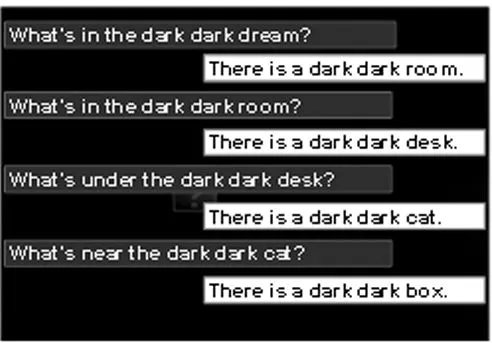修订版PEP 五(上)Unit 5 There is a big bed Part B
2016-04-16方琼
方 琼
笔者有幸参加市级教研活动,听了两节同课异构课,内容是PEP 5 Unit 5 Part B Let’s learn。此课要求学生能听、说、读、写表示位置关系的单词及词组:front,between,above,beside,behind,in front of。能灵活运用句型“Where is...?”“It’s...”谈论物体的位置。很明确这节课主要是五个方位介词的学习和运用,但由于没有前面课时的铺垫,“There be”句型也成为一个新授的内容。如何让这堂课激发学生学习的兴趣,又达到较好的教学效果?两位教师凭借丰富的经验,教出了自己的特色。
一、课前热身环节
【教师A的热身】
T:Hello,boys and girls.Let’ssingasong “ON IN UNDER BY”.(通过歌曲调动学生积极性,by这个单词是第一次接触,教师就用手势让学生明白它的意思)
T:OK!Iam yournew teacher today! Please know something about me.(名字、年龄、爱好、饮料、动物、实物、颜色等方面的问题让学生问,对学过的句型进行复习。学生很好奇有关教师的一切,所以集中了注意力)
【教师B的热身】
T:Hello,boys and girls!I’m your new English teacher today!Look!This is me,I’m 33 years old.I’m a teacher and I like reading very much.I have an English name.Can you guess my English name?
T:Look! There are 5 letters in my name.And you can find the letters in Picture B.Look! Find the difference in Picture B.Who knows?
T:Can you read? Now,I want to know something about you.(通过出示两张图,让学生找不同,拼出教师的英文名,学生非常兴奋,课堂气氛一下子活跃起来。)
【对比与分析】教师A先通过演唱歌曲“ON IN UNDER BY”,并配合手指动作,复习学过的方位介词,为当天要新授的单词做好了铺垫。教师B则通过课前谈话:猜名字的字母找出B图的不同点,提高五年级学生的注意力,为后面的“There be”句型做好了铺垫。
二、新课的导入环节
【教师A的教学导入】
T:Where is the spider?It’s____the sea.引出主情境。
T:What can you see under the sea?
S:I can see fish/grass...
【教师B的教学导入】
T:Today,let’s meet a new friend.Look,his name is David.But his mum always calls him:WhereWhereDavid.“Where WhereDavid,gotobed!”“Where Where David,come here!”Do you know why?Let’s go and find the answer.(让学生看做梦的课件)
T:Look,David is in the dream,what’s inthedream?Please look carefully and then answer my question:What’s in the dream.(由这个梦引出“There is a...”句型)
【对比与分析】教师A以小鱼John去上学为主线,从这里开始发展情境。先通过PPT出现Spider在海边的图片,并复习方位词。接着欣赏海底照片,让学生看海底有什么呢?学生会用“I can see...”句型进行操练。教师B引出David这个人物,设置悬念:为什么妈妈叫他“Where Where David”?通过梦里的遭遇进行自然渗透和了解,对“There is”句型复习。这个梦是参照六年级的一篇课文改编的非常吸引学生的眼球。


三、新课呈现环节
【教师A的教学呈现】
T:Look,this is John and who is he?He is John’s dad.Dad isbesideJohn,John is beside dad.(由两者的位置关系教授新的单词beside,并对beside/near/next to进行了比较说明)
T:John is on his way to school,he meets Tom.John is above Tom.(由两者的位置引出新词above,教师领读、板书,学生朗读,并运用“There be”句型描述图片)
T:Where is John now?He is below the grass.(有PPT展示位置,教学above的反义词below)
T:John goes on,he meets Mike and Amy.Where is he?He is between Mike and Amy.(引出 between,适当拓展“between...and...”这一搭配)
T:There are many fishes.Where is John?He is in front of the fishes.(用图片展示的形式教学“in front of”和 behind,并用“There be”句型描述图片)
【教师B的教学呈现】
1.“Where is...”句型的问答呈现。
Mum:Get up!Get up!It’s time to go to school!
David:Mum,where is my T-shirt?Where are my socks?
T:Now,do you know why his mum calls him:Where Where David?
S:Yes,because he always can’t find his things,and ask for help,“Mum,where is my...”
T:Look,where is the T-shirt?(It’s on the bed!)
T:Where are the socks?(They are under the bed)
2.找 jacket并教学“in front of”。
David:Mum,where is my jacket?
Mum:Where Where David,it’s in front of the computer!
(先让学生找jacket,再听mum 说,引出“in front of”)
3.找shoes并教学behind。
David:Mum, whereare my shoes?
Mum:Where Where David,they are behind the door!
4.找cap并教学above。
David:Mum,where is my cap?
Mum:Where Where David,it’s above the bed!
(PPT比较on和above)
5.找bag并教学beside。
David:Mum,mum,where is my school bag?
Mum:Where Where David,it’s beside the sofa!
(PPT比较 next to,beside和near)
6.找bike并教学between。
David:Mum,where is my bike?
Mum:Where Where David,it’s between the chairs.
【对比与分析】教师A通过出现两条鱼John和Dad,介绍它们的位置引出新词beside。出现一个闹钟,让学生知道鱼要去上学了。对next to,beside,near这三个单词顺势进行了复习比较,让学生有较为清楚的认知。上学路上John遇上到Tom,引出新词above,并补充反义词below。复习 比 较 above,below,on,under这四个单词并操练句型“Where is...It’s...”。上学路上John继续游,遇上Mike和Amy,引出 between,补充学习“between...and...”。之后出现一大群鱼,John游到它们的前面及后面,引出“in front of”和它的反义词behind.

教师B先让学生看图片,看见David总是找不到东西,学生就明白了为什么妈妈要叫他“Where Where David”。接着通过找jacket引出“in front of”;找 shoes 引出 behind;比较“in front of”和behind;找cap引出above,比较on和above;找bag引出beside,比较“next to”,near,beside;找 bike 引出between,提示between的用法。

四、巩固环节
【教师A的巩固设计】
1.Listen and do.学生根据卡片提示,站在台前/后/旁/上等位置,教师问:Where is...?学生回答:He is/She is...(综合复习五个方位词以及句型)
2.Look,listen and read.John来到了学校,看看他们教室学生的位置关系。
3.Look and fillin the blank.(请学生根据座位表选词填空)
4.Let’s write.
There is a/an _____( )the _______.
There are ______( )the_______.
【教师B的巩固设计】
1.Play a game:Where are you?
2.Find the differences.(教师简笔画房子,学生回答,然后黑板上贴图片)
3.Make a beautiful room.(小组完成后,让学生一起拍合照,对他们的合作表示鼓励)
4.Whatcan wesayto David?(你想对David说什么?引申到对学生的教育)

【对比与分析】
巩固环节是英语教学过程中必不可少的一个环节。这个环节通过巩固性操练,让学生当堂巩固新授知识,对于知识的掌握与落实有很重要的作用。A教师通过让学生看指令,站到正确的方位,学生进行句型操练“Where is…He is/She is…”,然后通过选选、填填、练练,使枯燥的练习变得趣味十足;教师B通过玩游戏、贴图片并通过拍照使学生们对合作成果有一种成就感、自豪感,最后根据整个故事,对学生进行思想渗透“你想对David说什么?”,使学生的情感得到升华,达到了画龙点睛之功效,学生学得扎实、学得有效。
